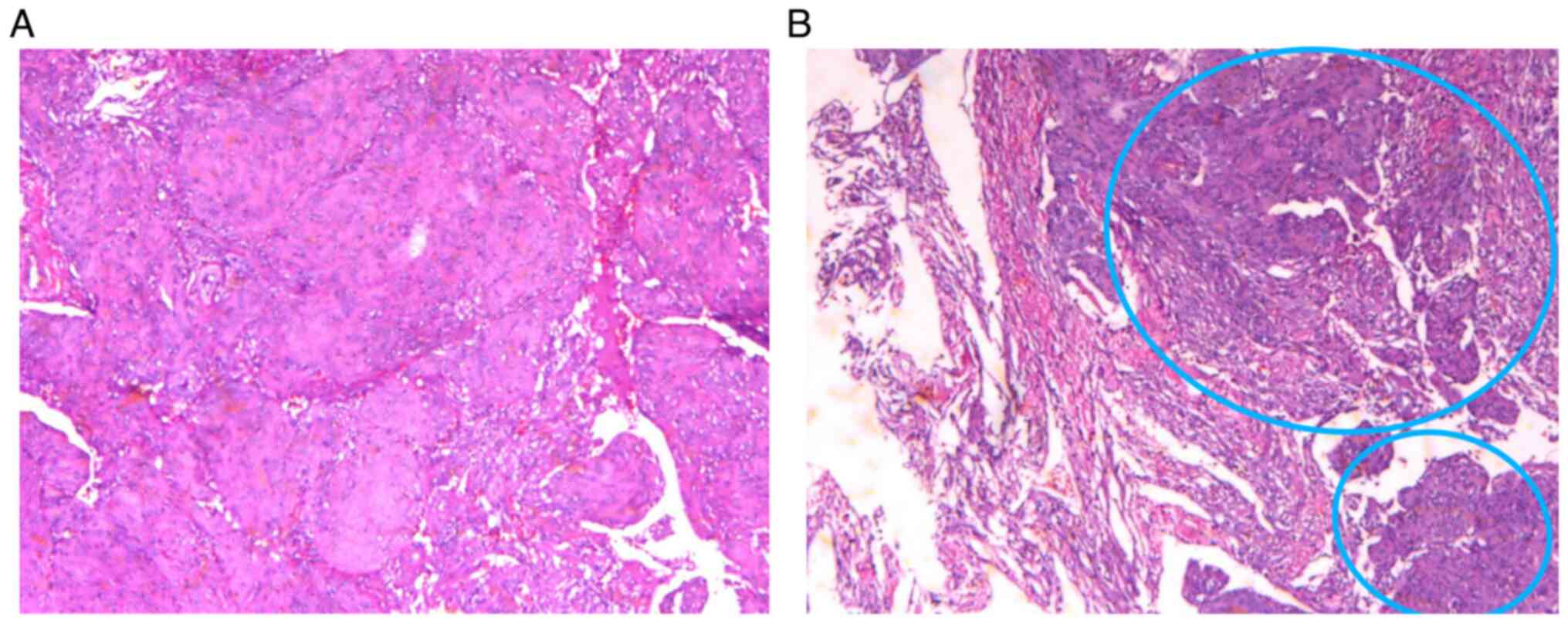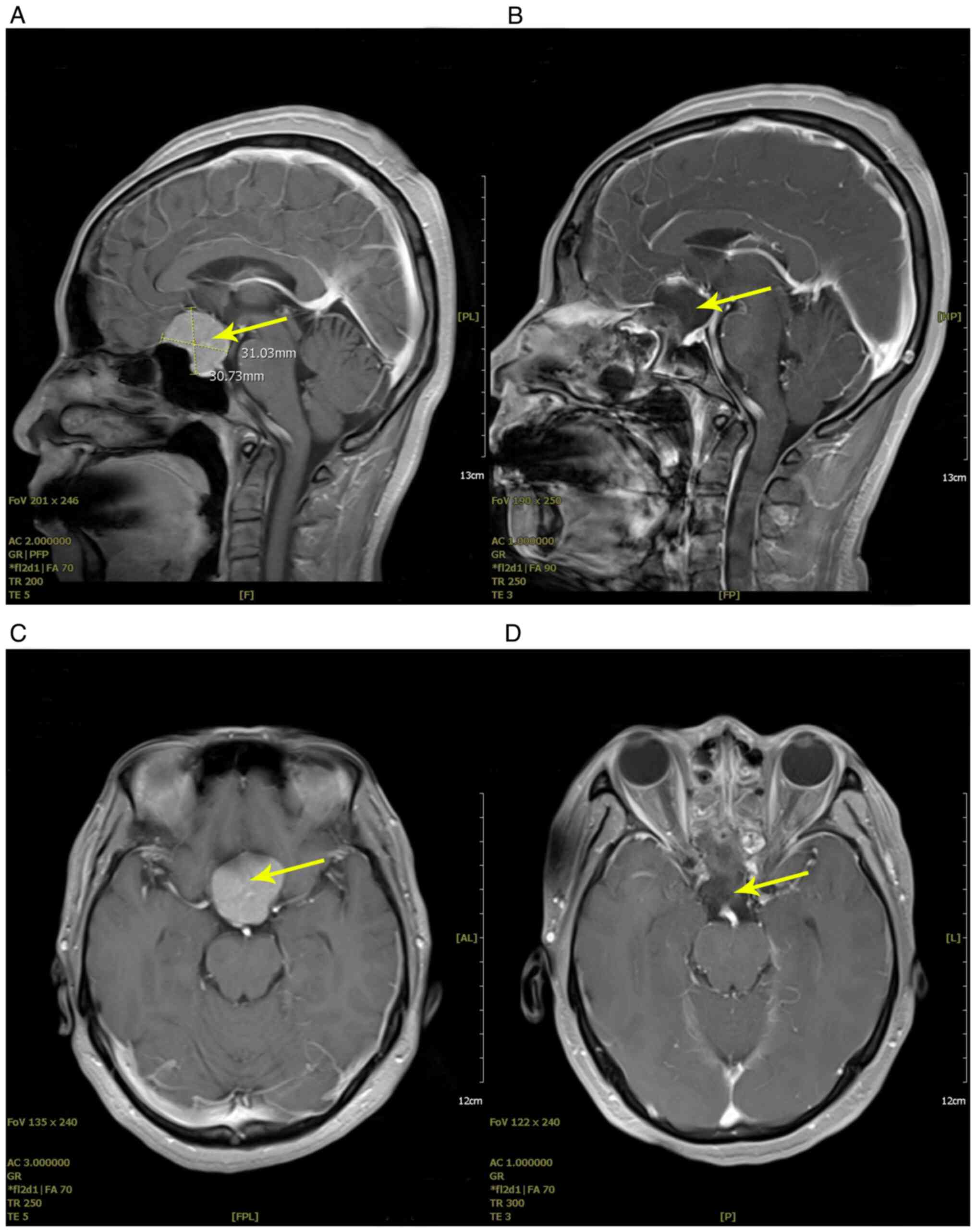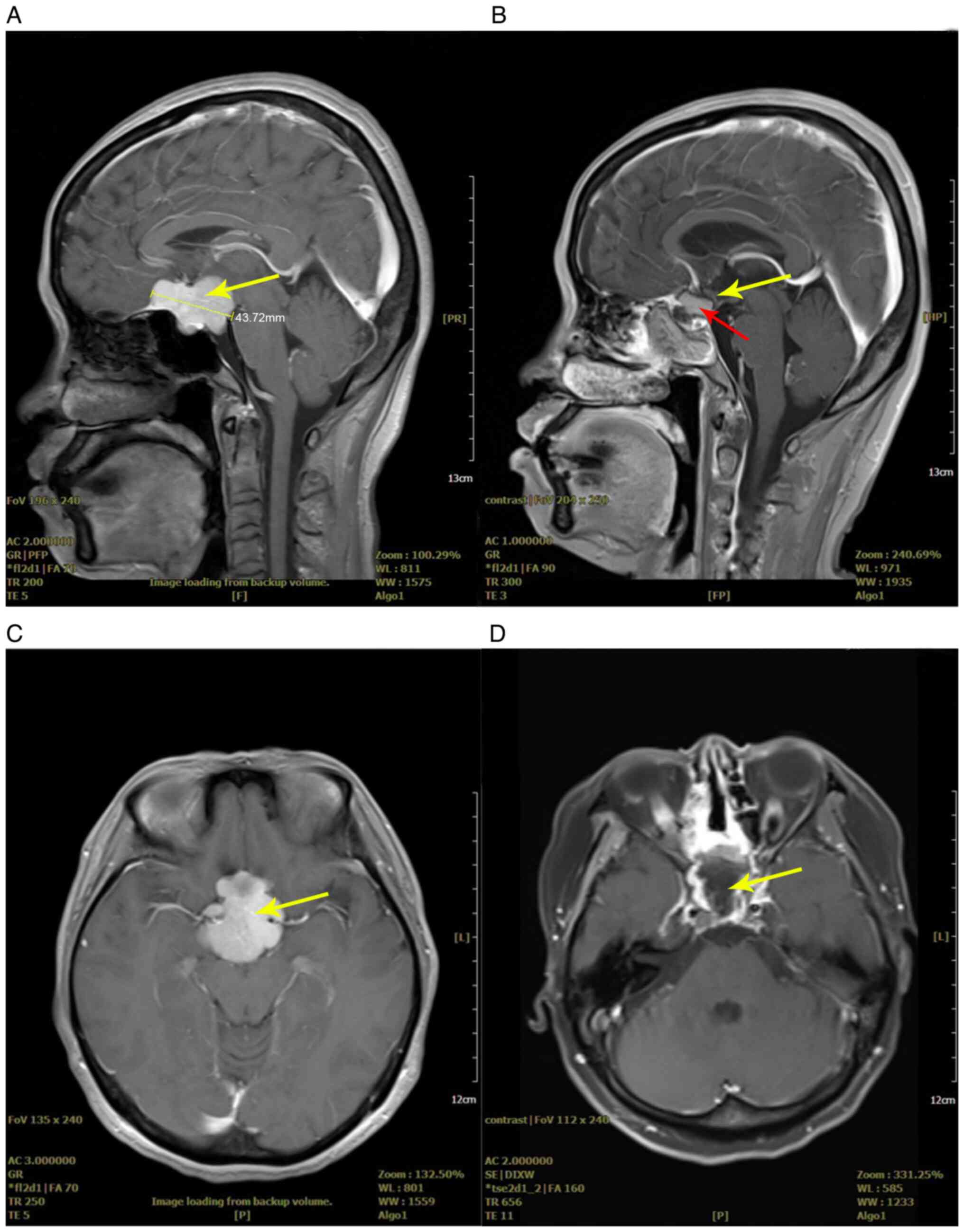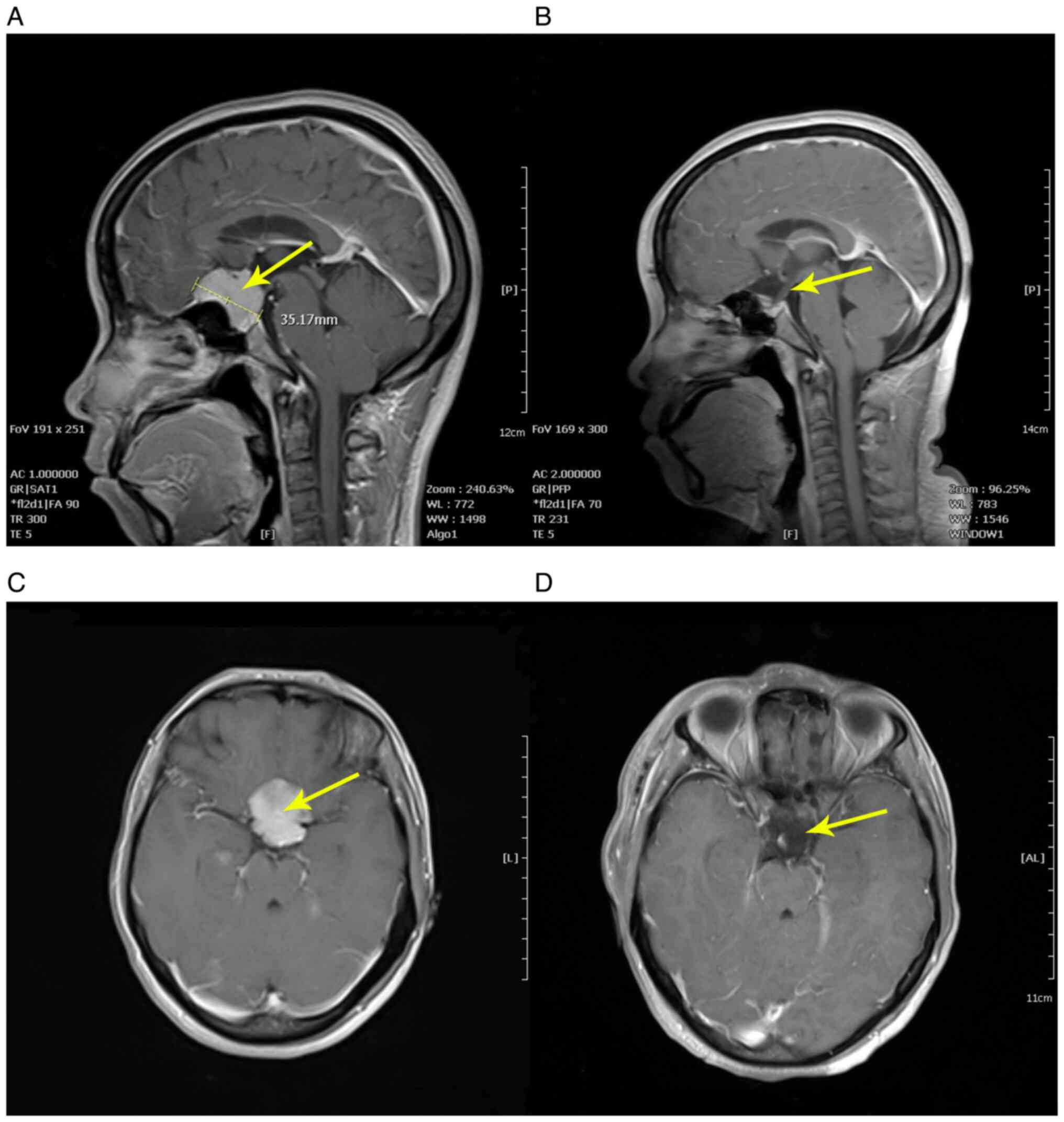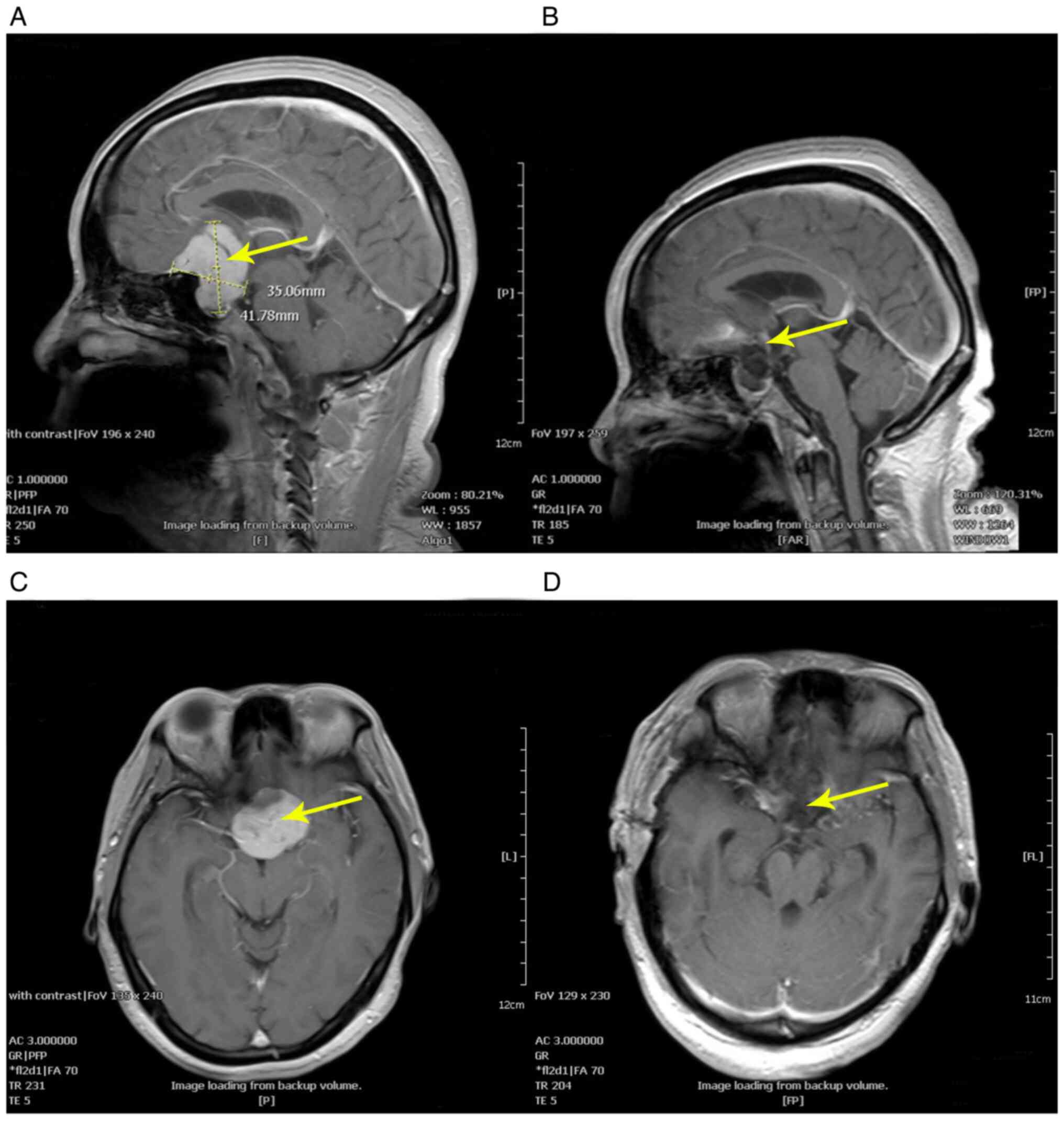|
1
|
Yu P, Xu T, Wu X, Liu Z and Wang Y and
Wang Y: The expanded endoscopic endonasal approach for treatment of
tuberculum sellae meningiomas in a series of 40 consecutive cases.
Sci Rep. 11(4993)2021.PubMed/NCBI View Article : Google Scholar
|
|
2
|
Sankhla SK, Jayashankar N, Khan MA and
Khan GM: Surgical management of tuberculum sellae meningioma: Our
experience and review of the literature. Neurol India.
69:1592–1600. 2021.PubMed/NCBI View Article : Google Scholar
|
|
3
|
Khan OH, Krischek B, Holliman D,
Klironomos G, Kucharczyk W, Vescan A, Gentili F and Zadeh G: Pure
endoscopic expanded endonasal approach for olfactory groove and
tuberculum sellae meningiomas. J Clin Neurosci. 21:927–933.
2014.PubMed/NCBI View Article : Google Scholar
|
|
4
|
Wang ZC: Neurosurgery. Hubei Science and
Technology Publishing House, Wuhan, 1998 (In Chinese).
|
|
5
|
Mahmoud M, Nader R and Al-Mefty O: Optic
canal involvement in tuberculum sellae meningiomas: Influence on
approach, recurrence, and visual recovery. Neurosurgery 67 (3 Suppl
Operative): onsS108-S118. discussion ons118-9, 2010.
|
|
6
|
Rubin G, Ben David U, Gornish M and
Rappaport ZH: Meningiomas of the anterior cranial fossa floor.
Review of 67 cases. Acta Neurochir (Wien). 129:26–30.
1994.PubMed/NCBI View Article : Google Scholar
|
|
7
|
Zhang C, Ding J, Liu Y, Tuoheti M, Yang X,
Wang J and Wu Y: Endoscopic endonasal approach for resection of
tuberculum sellae meningioma: A promising surgical approach. J
Craniofac Surg. 31:1815–1818. 2020.PubMed/NCBI View Article : Google Scholar
|
|
8
|
Tang H, Sun H, Xie L, Tang Q, Gong Y, Mao
Y, Xie Q, Zheng M, Wang D, Zhu H, et al: Intraoperative ultrasound
assistance in resection of intracranial meningiomas. Chin J Cancer
Res. 25:339–345. 2013.PubMed/NCBI View Article : Google Scholar
|
|
9
|
Nakamura M, Roser F, Jacobs C, Vorkapic P
and Samii M: Medial sphenoid wing meningiomas: Clinical outcome and
recurrence rate. Neurosurgery. 58:626–639. 2006.PubMed/NCBI View Article : Google Scholar
|
|
10
|
Nakamura M, Roser F, Struck M, Vorkapic P
and Samii M: Tuberculum sellae meningiomas: Clinical outcome
considering different surgical approaches. Neurosurgery.
59:1019–1028. 2006.PubMed/NCBI View Article : Google Scholar
|
|
11
|
Nakamura M, Struck M, Roser F, Vorkapic P
and Samii M: Olfactory groove meningiomas: Clinical outcome and
recurrence rates after tumor removal through the frontolateral and
bifrontal approach. Neurosurgery. 60:844–852. 2007.PubMed/NCBI View Article : Google Scholar
|
|
12
|
Jho HD and Carrau RL: Endoscopy assisted
transsphenoidal surgery for pituitary adenoma. Acta Neurochir
(Wien). 138:1416–1425. 1996.PubMed/NCBI View Article : Google Scholar
|
|
13
|
Adappa ND, Learned KO, Palmer JN, Newman
JG and Lee JY: Radiographic enhancement of the nasoseptal flap does
not predict postoperative cerebrospinal fluid leaks in endoscopic
skull base reconstruction. Laryngoscope. 122:1226–1234.
2012.PubMed/NCBI View Article : Google Scholar
|
|
14
|
Linsler S, Fischer G, Skliarenko V, Stadie
A and Oertel J: Endoscopic assisted supraorbital keyhole approach
or endoscopic endonasal approach in cases of tuberculum sellae
meningioma: Which surgical route should be favored? World
Neurosurg. 104:601–611. 2017.PubMed/NCBI View Article : Google Scholar
|
|
15
|
Simpson D: The recurrence of intracranial
meningiomas after surgical treatment. J Neurol Neurosurg
Psychiatry. 20:22–39. 1957.PubMed/NCBI View Article : Google Scholar
|
|
16
|
Cushing H and Eisenhardt L: Meningiomas
arising from the tuberculum sellae: With the syndrome of primary
optic atrophy and bitemporal field defects combined with a normal
sella turcica in a middle-aged person. Arch Ophthalmol. 1:168–206.
1929.
|
|
17
|
Shrivastava RK, Segal S, Camins MB, Sen C
and Post KD: Harvey Cushing's Meningiomas text and the historical
origin of resectability criteria for the anterior one third of the
superior sagittal sinus. J Neurosurg. 99:787–791. 2003.PubMed/NCBI View Article : Google Scholar
|
|
18
|
Hayhurst C and Teo C: Tuberculum sella
meningioma. Otolaryngol Clin North Am. 44:953–963, viii-ix.
2011.PubMed/NCBI View Article : Google Scholar
|
|
19
|
Chokyu I, Goto T, Ishibashi K, Nagata T
and Ohata K: Bilateral subfrontal approach for tuberculum sellae
meningiomas in long-term postoperative visual outcome. J Neurosurg.
115:802–810. 2011.PubMed/NCBI View Article : Google Scholar
|
|
20
|
Fahlbusch R and Schott W: Pterional
surgery of meningiomas of the tuberculum sellae and planum
sphenoidale: Surgical results with special consideration of
ophthalmological and endocrinological outcomes. J Neurosurg.
96:235–243. 2002.PubMed/NCBI View Article : Google Scholar
|
|
21
|
Soni RS, Patel SK, Husain Q, Dahodwala MQ,
Eloy JA and Liu JK: From above or below: The controversy and
historical evolution of tuberculum sellae meningioma resection from
open to endoscopic skull base approach. J Clin Neurosci.
21:559–568. 2014.
|
|
22
|
Perneczky A: Keyhole concept in
neurosurgery: With endoscope-assisted microsurgery and case
studies. Thieme, Stuttgart, New York, 1999.
|
|
23
|
Fischer G, Stadie A, Reisch R, Hopf NJ,
Fries G, Böcher-Schwarz H, van Lindert E, Ungersböck K, Knosp E,
Oertel J and Perneczky A: The keyhole concept in aneurysm surgery:
Results of the past 20 years. Neurosurgery. 68 (1 Suppl
Operative):S45–S51. 2011.PubMed/NCBI View Article : Google Scholar
|
|
24
|
Reisch R and Perneczky A: Ten-year
experience with the supraorbital subfrontal approach through an
eyebrow skin incision. Neurosurgery. 57 (4 Suppl):S242–S255;
discussion 242-55. 2005.PubMed/NCBI View Article : Google Scholar
|
|
25
|
Reisch R, Perneczky A and Filippi R:
Surgical technique of the supraorbital key-hole craniotomy. Surg
Neurol. 59:223–227. 2003.PubMed/NCBI View Article : Google Scholar
|
|
26
|
Hernesniemi J, Ishii K, Niemelä M, Smrcka
M, Kivipelto L, Fujiki M and Shen H: Lateral supraorbital approach
as an alternative to the classical pterional approach. Acta
Neurochir Suppl. 94:17–21. 2005.PubMed/NCBI View Article : Google Scholar
|
|
27
|
Kong DS, Hong CK, Hong SD, Nam DH, Lee JI,
Seol HJ, Oh J, Kim DG and Kim YH: Selection of endoscopic or
transcranial surgery for tuberculum sellae meningiomas according to
specific anatomical features: A retrospective multicenter analysis
(KOSEN-002). J Neurosurg. 130:838–847. 2018.PubMed/NCBI View Article : Google Scholar
|
|
28
|
Marx S, Clemens S and Schroeder HWS: The
value of endoscope assistance during transcranial surgery for
tuberculum sellae meningiomas. J Neurosurg. 128:32–39.
2018.PubMed/NCBI View Article : Google Scholar
|
|
29
|
Godano U: Transcranial approaches for
tuberculum sellae meningiomas in the endoscopic era. J Neurosurg
Sci. 65:457–459. 2021.PubMed/NCBI View Article : Google Scholar
|
|
30
|
Chowdhury FH, Haque MR, Goel AH and Kawsar
KA: Endoscopic endonasal extended transsphenoidal removal of
tuberculum sellae meningioma (TSM): An experience of six cases. Br
J Neurosurg. 26:692–699. 2012.PubMed/NCBI View Article : Google Scholar
|
|
31
|
Gardner PA, Kassam AB, Thomas A, Snyderman
CH, Carrau RL, Mintz AH and Prevedello DM: Endoscopic endonasal
resection of anterior cranial base meningiomas. Neurosurgery.
63:36–52; discussion 52-4. 2008.PubMed/NCBI View Article : Google Scholar
|
|
32
|
Koutourousiou M, Fernandez-Miranda JC,
Stefko ST, Wang EW, Snyderman CH and Gardner PA: Endoscopic
endonasal surgery for suprasellar meningiomas: Experience with 75
patients. J Neurosurg. 120:1326–1339. 2014.PubMed/NCBI View Article : Google Scholar
|
|
33
|
Abhinav K, Acosta Y, Wang WH, Bonilla LR,
Koutourousiou M, Wang E, Synderman C, Gardner P and
Fernandez-Miranda JC: Endoscopic endonasal approach to the optic
canal: Anatomic considerations and surgical relevance.
Neurosurgery. 11 Suppl 3:431–445; discussion 445-6. 2015.PubMed/NCBI View Article : Google Scholar
|
|
34
|
de Divitiis E, Cavallo LM, Esposito F,
Stella L and Messina A: Extended endoscopic transsphenoidal
approach for tuberculum sellae meningiomas. Neurosurgery. 61 (5
Suppl 2):S229–S237; discussion 237-8. 2007.PubMed/NCBI View Article : Google Scholar
|
|
35
|
Black PM, Zervas NT and Candia GL:
Incidence and management of complications of transsphenoidal
operation for pituitary adenomas. Neurosurgery. 20:920–924.
1987.PubMed/NCBI View Article : Google Scholar
|
|
36
|
Jallu A, Kanaan I, Rahm B and Siqueira E:
Suprasellar meningioma and blindness: A unique experience in Saudi
Arabia. Surg Neurol. 45:320–323. 1996.PubMed/NCBI View Article : Google Scholar
|
|
37
|
Grisoli F, Diaz-Vasquez P, Riss M,
Vincentelli F, Leclercq TA, Hassoun J and Salamon G: Microsurgical
management of tuberculum sellae meningiomas. Results in 28
consecutive cases. Surg Neurol. 26:37–44. 1986.PubMed/NCBI View Article : Google Scholar
|
|
38
|
Park CK, Jung HW, Yang SY, Seol HJ, Paek
SH and Kim DG: Surgically treated tuberculum sellae and diaphragm
sellae meningiomas: The importance of short-term visual outcome.
Neurosurgery. 59:238–243. 2006.PubMed/NCBI View Article : Google Scholar
|
|
39
|
Lee JH, Jeun SS, Evans J and Kosmorsky G:
Surgical management of clinoidal meningiomas. Neurosurgery.
48:1012–1021. 2001.PubMed/NCBI View Article : Google Scholar
|
|
40
|
Komotar RJ, Starke RM, Raper DM, Anand VK
and Schwartz TH: Endoscopic endonasal versus open transcranial
resection of anterior midline skull base meningiomas. World
Neurosurg. 77:713–724. 2012.PubMed/NCBI View Article : Google Scholar
|















